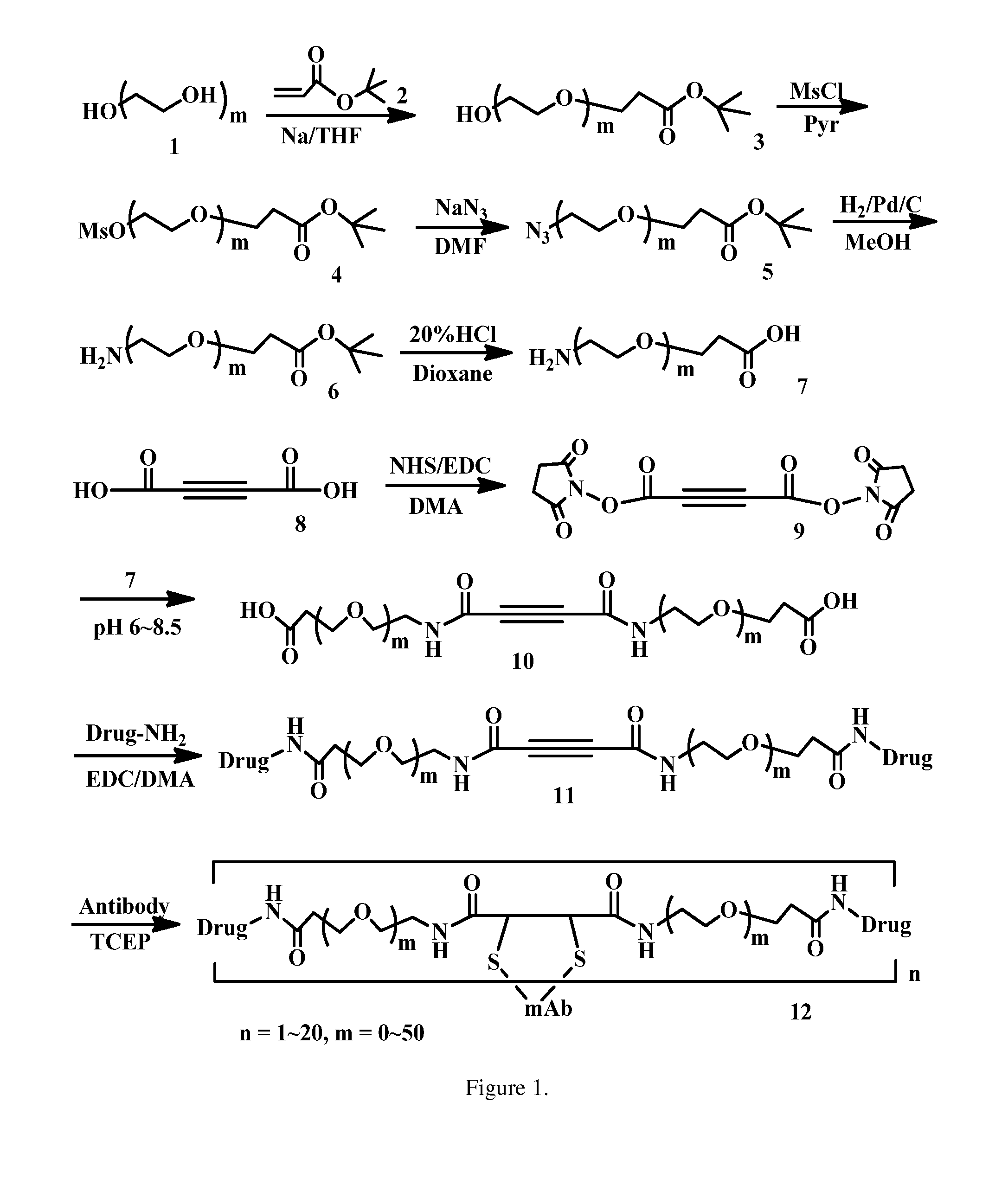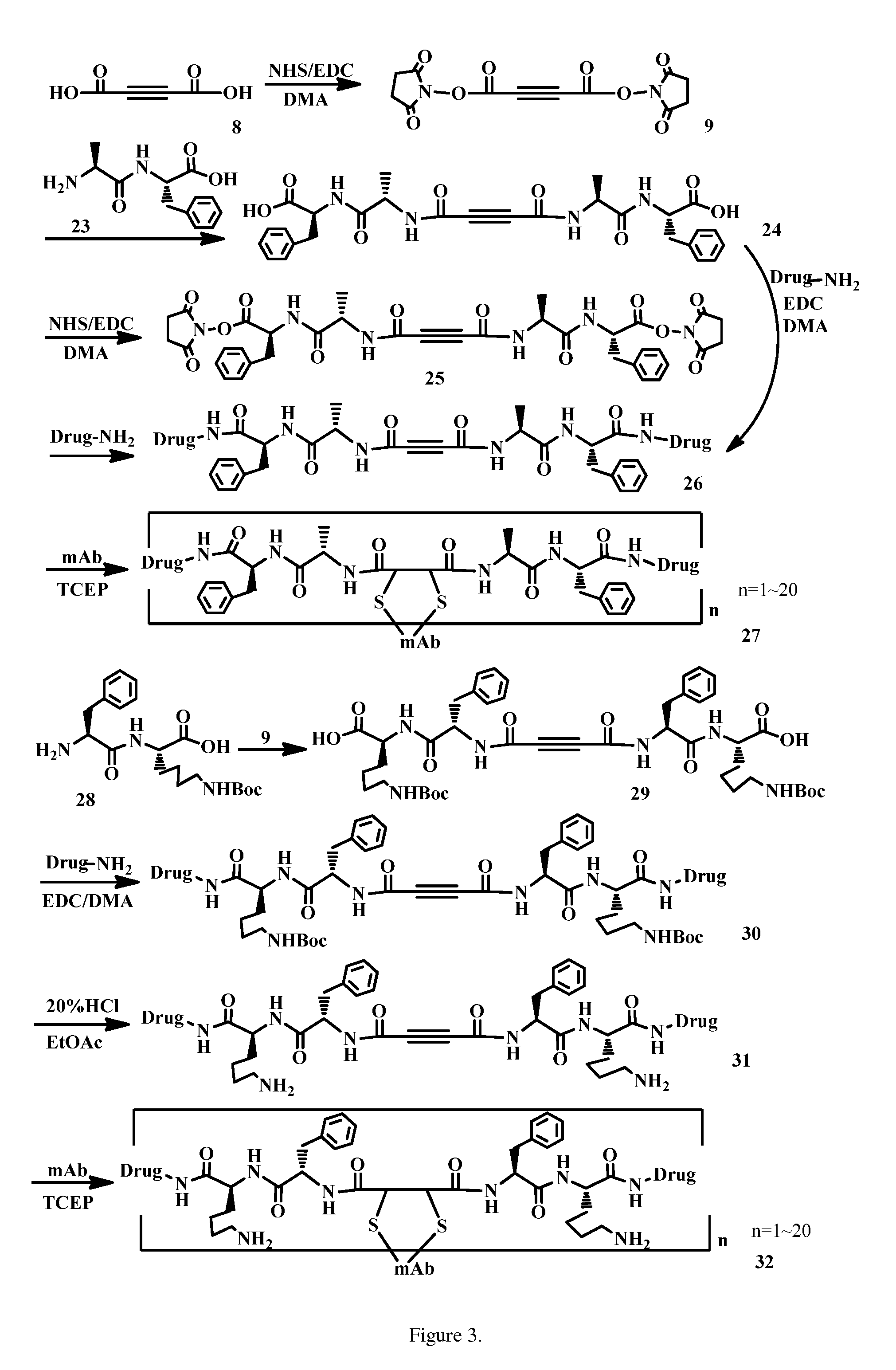Acetylenedicarboxyl linkers and their uses in specific conjugation of a cell-binding molecule
a technology of acetylenedicarboxyl linkers and specific conjugation, which is applied in the direction of dipeptide ingredients, immunoglobulins against animals/humans, peptides, etc., can solve the problems of shortening the half-life of circulation, increasing off-target toxicity, and reducing the efficacy
- Summary
- Abstract
- Description
- Claims
- Application Information
AI Technical Summary
Benefits of technology
Problems solved by technology
Method used
Image
Examples
example 1
tert-Butyl 3-(2-(2-(2-hydroxyethoxyl)ethoxy)ethoxy)propanoate (34)
[0161]
[0162]To 350 mL of anhydrous THF was added 80 mg (0.0025 mol) of sodium metal and triethylene glycol 2 (150.1 g, 1.00 mol) with stirring. After the sodium had completely dissolved, tert-butyl acrylate (24 mL, 0.33 mol) was added. The solution was stirred for 20 h at room temperature and neutralized with 8 mL of 1.0 M HCl. The solvent was removed in vacuo and the residue was suspended in brine (250 mL) and extracted with ethyl acetate (3×125 mL). The combined organic layers were washed with brine (100 mL) then water (100 mL), dried over sodium sulfate, and the solvent was removed. The resulting colorless oil was dried under vacuum to give 69.78 g (76% yields) of product 34. 1H NMR: 1.41 (s, 9H), 2.49 (t, 2H, J=6.4 Hz), 3.59-3.72 (m, 14H). ESI MS m / z− C13H25O6 (M−H), cacld. 277.17, found 277.20.
example 2
tert-Butyl 3-(2-(2-(2-(tosyloxy)ethoxy)ethoxy)ethoxy)propanoate (35)
[0163]
[0164]A solution of 34 (10.0 g, 35.95 mmol) in acetonitrile (50.0 mL) was treated with pyridine (20.0 mL). A solution of tosyl chloride (7.12 g, 37.3 mmol) in 50 mL acetonitrile was added dropwise via an addition funnel over 30 minutes. After 5 h TLC analysis revealed that the reaction was complete. The pyridine hydrochloride that had formed was filtered off and the solvent was removed. The residue was purified on silica gel by eluting from with 20% ethyl acetate in hexane to with neat ethyl acetate to give 11.2 g (76% yield) of compound 35. 1H NMR: 1.40 (s, 9H), 2.40 (s, 3H), 2.45 (t, 2H, J=6.4 Hz), 3.52-3.68 (m, 14H), 4.11 (t, 2H, J=4.8 Hz), 7.30 (d, 2H, J=8.0 Hz), 7.75 (d, 2H, J=8.0 Hz); ESI MS m / z+C20H33O8S (M+H), cacld. 433.18, found 433.30.
example 3
tert-Butyl 3-(2-(2-(2-azidoethoxyl)ethoxy)ethoxy)propanoate (36)
[0165]
[0166]To 50 mL of DMF was added tert-butyl 3-(2-(2-(2-(tosyloxy)ethoxy)ethoxy)ethoxy)-propanoate 35 (4.0 g, 9.25 mmol) and sodium azide (0.737 g, 11.3 mmol) with stirring. The reaction was heated to 80° C. After 4 h TLC analysis revealed that the reaction was complete. The reaction was cooled to room temperature and quenched with water (25 mL). The aqueous layer was separated and extracted into ethyl acetate (3×35 mL). The combined organic layers were dried over anhydrous magnesium sulfate, filtered, and the solvent removed in vacuo. The crude azide (about 90% pure by TLC) was used without further purification. 1H NMR (CDCl3): 1.40 (s, 9H), 2.45 (t, 2H, J=6.4 Hz), 3.33 (t, 2H, J=5.2 Hz), 3.53-3.66 (m, 12H). ESI MS m / z+ C13H26N3O8 (M+H), cacld. 304.18, found 304.20.
PUM
| Property | Measurement | Unit |
|---|---|---|
| concentration | aaaaa | aaaaa |
| pH | aaaaa | aaaaa |
| pH | aaaaa | aaaaa |
Abstract
Description
Claims
Application Information
 Login to View More
Login to View More - R&D
- Intellectual Property
- Life Sciences
- Materials
- Tech Scout
- Unparalleled Data Quality
- Higher Quality Content
- 60% Fewer Hallucinations
Browse by: Latest US Patents, China's latest patents, Technical Efficacy Thesaurus, Application Domain, Technology Topic, Popular Technical Reports.
© 2025 PatSnap. All rights reserved.Legal|Privacy policy|Modern Slavery Act Transparency Statement|Sitemap|About US| Contact US: help@patsnap.com



